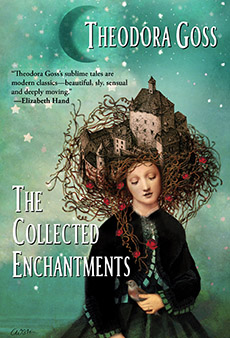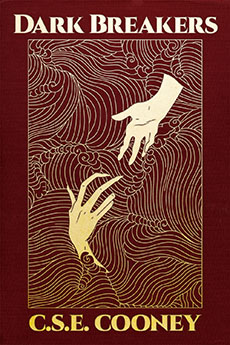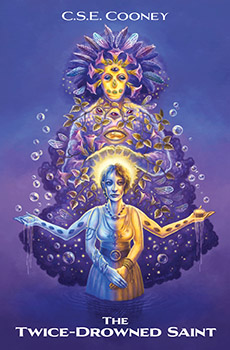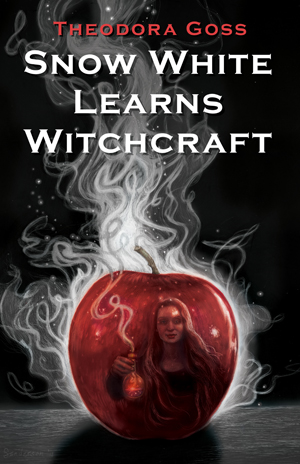A Clockwork Phoenix Featured Story
Selected Program Notes from the Retrospective Exhibition of Theresa Rosenberg Latimer
Kenneth Schneyer

1. Three Women (1978)
Oil on canvas, 30 x 40"
Detroit Institute of Art, Detroit, Michigan
Latimer painted Three Women while still a student at the Rhode Island School of Design. It is the earliest completed painting that displays the hyperrealism characterizing the first period of her work.
Three young women sit close together on a park bench in autumn. Two hold hands, while the third has her hand on the knee of the center figure. Their expressions are serious, almost stern, as if they resent the artist’s presumption in portraying them.
At this stage of her career, Latimer was still experimenting with issues of compositional balance. The brightness of the orange trees offsets the dour colors of the models’ clothes; the tilt of the models’ heads and the orientation of their legs impel the viewer to look at the trees rather than at them. It as if the viewer is being pushed away from people and towards nature.
None of these models appears in any of Latimer’s later work. Presumably they were fellow RISD students. Latimer herself appears in early works of others who were at RISD at the time, including A. C. Stahl and J. J. Kramer.
Discussion questions:
a. Use the magnifying lens provided to examine the hairs on the models’ arms, the loose fibers in their sweaters, and the veins in the leaves. Many details in a Latimer painting are not visible to those who view the work at ordinary distances. Why do you think she inserted such typically invisible minutiae? What effect do they have on your experience of the painting?
19. Self-Portrait with Surrogates (1984)
Oil on canvas, 51 x 77¼"
Rhode Island School of Design Museum, Providence, Rhode Island
The first of Latimer’s paintings to draw critical attention, Self-Portrait with Surrogates portrays the notorious child abuse and murder case of the Wilson family, which dominated the Rhode Island news media at the time. Seven-year-old Lisa Wilson, clad only in underwear and displaying both old scars and fresh cuts, is being beaten with an electrical extension cord wielded by her father, while her mother holds her in place. None of the figures displays any emotion; it is as if they are spectators at the event.
The details, again in the hyperrealist style, closely match those of the Wilson case. The family home is accurately depicted, and the scars on Lisa Wilson’s body correspond with photographs in the court file.
Discussion questions:
a. The composition and live-action flavor of this work resemble 18th- and 19th-century patriotic or polemical depictions of battles and famous events; David’s The Death of Socrates (1787) (Fig. 5) is a clear influence. Why does Latimer employ such devices in a portrayal of domestic violence? Does it alter your perception of what you are “really” seeing?
b. Some biographers associate the painting’s title with the emotional and physical abuse Latimer herself experienced as a child. Is there anything in the picture itself to show that this is really a “self portrait?”
c. Does the fact that Latimer’s parents were living when she painted this work alter the way you perceive it?
34. Magda #4 (1989)
Oil on poplar wood, 30 x 21"
Private collection
Sometimes called “Devotion” by critics, this nude is the earliest extant work featuring Magda Ridley Meszaros (1963-2023), Latimer’s favorite model and later her wife. The lushness of the flesh and the rosiness of the skin are reminiscent of Renoir’s paintings of Aline Charigot (see, e.g., The Large Bathers (1887) (Fig. 8)). Latimer maintains microscopic hyperrealism even as she employs radiating brushstrokes which emanate from the model, as if Meszaros is the source of reality itself.
Discussion questions:
a. The materials and dimensions of this painting duplicate those of Da Vinci’s La Gioconda (c. 1503-1519) (Fig. 17). Is this merely a compositional joke or homage by Latimer? How does it change the way you see the painting?
b. Most biographers agree that Latimer and Meszaros were already lovers by the time this work was completed. Is this apparent from the composition or technique? From the pose of the model? As you proceed through the exhibit, note similarities and differences between this and other portrayals of Meszaros over the next 34 years.
48. Conjuring (1993)
Acrylic on masonite, 48 x 96"
Private collection
Her largest composition and only known landscape, Conjuring appeared during a fallow period in Latimer’s work. In 1992 and 1993 she completed only three paintings.
The scene is an overcast day in a valley in northern New Hampshire. Although it is summer, the foliage on the hills contains much grey and purple, conveying a wintery feel. While Latimer renders exacting details in rocks, trees, even blades of grass, in this work she also employs a forced monotony in the brushwork; the shape of every stroke is practically identical to every other.
In the precise center of the composition, wearing baggy khaki clothing, Magda Ridley Meszaros walks along an empty dirt road, recognizable only under a magnifying lens. She does not appear to be aware of the artist.
Discussion questions:
a. The aforementioned slack period in Latimer’s work coincided with several crises in her life: her only interval of estrangement from Magda Meszaros, precipitated by parental opposition to their relationship; the death by drug overdose of her close friend, the singer Pamela Enoch (1965-1993); and Latimer’s own life-threatening illness. Her hyperrealist period ends with this painting. Can we see these life crises in this composition? Is there any hint of Latimer’s coming change in style?
49. Performance (1994)
Acrylic on canvas, 32 x 41"
National Portrait Gallery, Washington, D.C.
Generally regarded as one of the outstanding memorial portraits of the 20th century, Performance is also the first painting of Latimer’s “highlight” period, which occupied the rest of her career.
Latimer was fascinated by the restoration of the Sistine Chapel ceiling (1980-1994), which sharply enhanced the clarity and brightness of Michelangelo’s colors. Although some still doubt whether the restoration reflected the artist’s intentions, Latimer was most interested in the side-by-side contrast between the pre- and post-restoration appearance of the frescoes (see “before” and “after” pictures of The Creation of Adam (figs. 11 and 12)). In one of her diaries, she wrote:
They stripped away the hurts and filth of five centuries and released the purity within. It’s like looking at one of the Platonic forms—beneath the battered, mundane person, the person we see in everyday life, is the true person—the soul, maybe, or the heart. Of course it looks less “real” to us—we’re so used to the violence and degradation imposed on us by the world that we’re unprepared for ourselves without it.
How did I miss this before? Maybe I wasn’t ready, til now, to understand it. But after what happened, what’s still happening, this is the perfect tool, maybe the only tool.
After 1994, nearly all of Latimer’s paintings feature one or more “highlight figures,” people in a painting whose coloration has the clarity and brightness of the restored Sistine Chapel frescoes, as contrasted with the duller, more commonplace tones of everything else in the composition. They seem out-of-place and fantastical, even cartoonish, and yet Latimer employed the same level of microscopic detail in her “highlight figures” as in their surroundings.
The first critics who saw Performance misunderstood Latimer’s introduction of “highlight” figures, because the painting is set on the stage of the Providence Performing Arts Center, and the central figure is the artist’s recently deceased friend, the singer Pamela Enoch. Because she appears on the stage as if she were performing a concert, Enoch’s heightened colors were taken at the time to represent the effect of theatrical spotlights. Arthur Mallory’s review called the lighting “sentimental in an otherwise naturalistic work,” noting that true spotlights would have enhanced the colors of the surrounding stage as well.
Magda Meszaros is visible in the front row, the only member of the audience. She has turned in her seat to face the artist. Meszaros is not portrayed as a “highlight” figure, but in the same comparatively muted tones as the theatre.
Discussion questions:
a. As you view the many “highlight” figures in the remaining paintings in this exhibit, consider whether these figures seem more or less “real” to you than those painted in ordinary colors. Why?
b. Critics and biographers have puzzled over Latimer’s words, “what happened, what’s still happening,” which seem to refer to the event or events that inspired or impelled her to adopt the “highlight” style. But what events were they, and how did they lead to this change?
c. Not until 2025 did Latimer paint Magda Ridley Meszaros as a “highlight” figure. Usually she appears in ordinary tones, as here. Why is this so?
d. Why does Meszaros wear a puzzled expression?
59. Critique (1997)
Acrylic on canvas, 44 x 67"
Davison Art Center
Wesleyan University, Middletown, Conneticut
Latimer painted this piece to commemorate the addition of her Self-Portrait with Surrogates (#19) to the permanent collection of the RISD Museum. The setting is the Contemporary Artists gallery of the Museum; Self-Portrait with Surrogates hangs at the center of the composition, with adjacent works also visible, notably Intelligentsia (1986) by her friend and classmate J. J. Kramer.
In the foreground is the child Lisa Wilson (the subject of Self-Portrait with Surrogates) painted as a “highlight” figure. The young girl is presented as if she were a critical viewer of Self-Portrait with Surrogates; she is turned three-quarters toward the artist, but her left hand is raised toward the painting in a dismissive gesture. Her face is wry and full of humor; she appears to like the artist, even if she does not think much of the painting.
Discussion questions:
a. How do you interpret Lisa Wilson’s apparent attitude towards Latimer’s earlier painting? Is Latimer ridiculing her own work?
b. Why is Lisa Wilson portrayed as younger than she was in Self-Portrait with Surrogates? Why without visible evidence of abuse? What is the significance of the party dress she wears?
60. Excerpt from The Silent Voices (1997)
Video recording, 23 Min.
By permission of WGBH Television and the Public Broadcasting Service.
While working on Critique, Latimer was one of the subjects of Elijah Baptista’s video documentary concerning contemporary artists, The Silent Voices. In the excerpt shown here, she stands in the Contemporary Artists Gallery, making preliminary drawings. Oddly, she is not sketching the gallery or the paintings on the wall, but detailing the face of Lisa Wilson herself. Although there are no photographs or prior sketches evident (apart from Self Portrait with Surrogates), the drawing is precise, showing the same wry expression that will appear in the finished work.
Discussion questions:
a. Now that you see Latimer’s manner of speaking and moving, are you surprised? Does she seem like the sort of person who would produce this sort of work?
b. At the end of the excerpt, Baptista asks Latimer why she needed to come to the Museum in order to sketch a study of Wilson’s face. Latimer’s answer is, “You have to paint what you see, not what you think you’re supposed to see.” This admonition is a commonplace among visual artists. What does it mean when uttered by someone who paints with such obvious imagination?
72. Grace (2001)
Acrylic on canvas, 20 x 60"
Massachusetts Museum of Contemporary Art, North Adams, Massachusetts
One of several pieces recounting Latimer’s difficult relationship with her parents, Grace portrays a Thanksgiving dinner in their home. Her father, Mason Latimer (1930-2008), poses as if saying grace before the meal, but both he and his wife Sheila Rosenberg (1935-2014) are staring scornfully at Theresa Rosenberg Latimer and Magda Ridley Meszaros, who sit at the opposite end of the table, looking down at their plates.
Standing behind the artist and Meszaros, apparently observed by no one, is Pamela Enoch (the subject of Performance, #49), the only “highlight” figure in the composition. Smiling, she holds her palms above the heads of her two friends as if in benediction.
Discussion questions:
a. Critics have noted references in this painting to both Rockwell’s Freedom From Want (1943) (Fig. 18) and Dali’s Sacrament of the Last Supper (1955) (Fig. 19). What is the point of quoting two such wildly disparate pieces together? Is this a parody?
b. Pamela Enoch appears in many of Latimer’s works after 1994, always as a “highlight” figure in her mid-twenties, dressed for a performance. Why repeat the same person so often, and why always in the same clothes? Is Enoch a symbolic figure?
91. The Mourners (2008)
Acrylic on canvas, 20 x 30"
American Labor Museum, Haledon, New Jersey
The setting is a parking lot in Pawtucket, Rhode Island, that stands on the location of the 1908 Alger’s Mill fire, in which 34 workers were killed. Two distinct groups of “highlight” figures appear. Near the center stand the Alger brothers, the Mill owners whose negligence was generally blamed for the deaths, although none were ever prosecuted. They bow their heads and clasp their hands before them. Standing in a circle around them are 25 victims of the fire, their own sorrowful gazes fixed on the Alger brothers. All are dressed as they would have been in the late 19th or early 20th centuries.
Here, as elsewhere, Latimer has been praised for the quality of her research. Although historians have authenticated the faces of most of the fire victims, many of the relevant photographs have taken years or even decades to find.
Discussion questions:
a. Most of the figures in this painting are younger than they were at the time of the 1908 fire. Tara Aquino, in her assiduous tally of Latimer’s subjects (2038), has calculated that 84% of the “highlight” figures are in their 20s and 30s, and the rest are mostly children. By contrast, Latimer’s non-highlighted figures show an ordinary spread of ages. Why does Latimer make this age distinction between “highlight” and “ordinary” figures? Why not portray people as they were at the time of the relevant events?
b. One of the striking things about this painting is that the victims appear to be mourning for those who were responsible for their deaths. What is Latimer’s message here?
c. Young Lisa Wilson, a recurring figure in Latimer’s work, is visible at the far right of the composition, gesturing towards the group of mourning figures. Why include a contemporary figure in an otherwise period group? Is there a connection between this painting and the others in which she appears?
117. Self-Portrait with Family (2015)
Acrylic on canvas, 36 x 45"
Private collection
The setting is Latimer’s own bedroom, recognizable from the furniture and memorabilia. Latimer at her then-current age of 56 crouches in the bed in a nightgown, her face hidden in her hands as if in fear, sorrow, or pain. Standing by the side of the bed, glowering down at their daughter in reproach or rage, are her parents Mason Latimer and Sheila Rosenberg. They are “highlight” figures.
Kneeling on the bed with Latimer is Magda Meszaros. Both are painted in muted colors, as contrasted with the highlighted parents. Meszaros is in a protective posture, one hand on Latimer’s curved back and the other gesturing as to repel an invader.
Discussion questions:
a. Why does the artist paint her parents as they appeared in their twenties, before her own birth?
b. Why are neither Meszaros’s fierce gaze nor her guardian hand directed at the figures of the parents (the only other people in the composition), but at a point beyond the right border of the picture?
c. This work was composed in the year following Sheila Rosenberg’s death from brain cancer, which was also the year in which Latimer and Meszaros finally married. How many uses of the word “family” are implied by the title?
131. To Interfere, for Good, in Human Matters (2018)
Acrylic on canvas, 30 x 60"
F. Cooley Memorial Art Gallery, Reed College, Portland, Oregon
The scene is a crowded street in downtown Providence. A homeless woman with a young child sits on the doorstep of what may be a church; they are malnourished, shabbily dressed, and the woman holds out her hand as if asking for alms. The dozens of others on the street around her are a mix of both “highlight” figures and characters painted in muted colors (as are the beggar woman and her child). The composition pushes the eye of the viewer back and forth between the different groups in a sort of tennis match: from a “highlight” figure one is drawn to a muted figure, then to another “highlight” figure, then to another muted figure, back and forth until one has scrutinized every figure in the picture.
This oscillation forces the viewer to see the contrast between these two groups. Superficially, the muted figures wear everyday clothes contemporary to 2018, while the “highlight” figures are clad in varying styles from the previous 150 years. More significant, however, are their differing reactions to the homeless pair. The muted figures bypass the seated beggars, or approach them while looking elsewhere; a few are watching them from the corners of their eyes. The “highlight” figures, on the other hand, all stand motionless, each facing the mother and child, each with a look of pity or compassion on her or his face. Some reach out their hands as if to touch the pair, but none actually reach them.
Discussion questions:
a. As in other Latimer paintings, critics have observed references to other works, notably Courbet’s Real Allegory of the Artist’s Studio (1855) (Fig. 40) and Bosch’s Garden of Earthly Delights (c. 1504) (Fig. 41). Again, why does Latimer quote from two such different pieces?
b. Athena Ptolemaios (2025) has suggested that there is a racial or cultural message here. The muted figures are turning away from one of their own, while the “highlight” figures reach out to the stranger. Are we being shown than it is easier to feel compassion for those who are far away, or different?
c. While her technique here earned much praise, Latimer has been criticized for the blatantness of the message. Thomas Taney (2030) was particularly scornful of Latimer’s unexplained use of a passage from Dickens’s A Christmas Carol (1843) as the title of the piece. Do you agree with Taney?
146. Almost (2022)
Oil on poplar wood, 30 x 21"
Private collection
Almost is the last portrait Latimer made of Magda Ridley Meszaros during the latter’s lifetime. It is an unsentimental portrayal, detailing the damage done by both breast cancer and chemotherapy with all the hyperrealist accuracy at Latimer’s command. From her favorite chair, Meszaros gazes quietly at the artist. One detects neither fear, defiance, nor even acceptance, only the affection of one life partner for another.
Standing on either side of Meszaros are four “highlight” figures: Pamela Enoch and three other women who have not been identified. They are looking not at Meszaros but at the artist, their arms held wide.
Discussion questions:
a. The subject, size and materials of Almost are identical to those of Magda #4 (#34), so that it is natural to compare them. Whereas the brushwork in Magda #4 pointed to Meszaros herself, in Almost the strokes radiate from the “highlight” figures; even the strokes with which Meszaros is painted come from them. What other differences do you see between the two works? What similarities?
b. Why are the “highlight” figures smiling?
155. Comfort (2025)
Acrylic on canvas, 11 x 8½"
Private collection
The last known completed work of Theresa Rosenberg Latimer is Comfort, found among her personal effects after her death by medication overdose at the age of 66.
It is a quadruple portrait, somewhat reminiscent of her Three Women (#1). The setting is the exterior of Latimer’s home, although the focus is so tight that only certain abnormalities in the brickwork allow us to identify it. The four figures are Pamela Enoch dressed for a performance, Lisa Wilson in her party dress, Magda Meszaros as a young model, and Latimer herself at 30, the beginning of her most productive period. Latimer stands slightly in the foreground, one step ahead of the others; Enoch and Wilson are to her left, Meszaros to her right, as if they are ready to catch her if she falls.
All four women are “highlight” figures, bright and clear with strong definitions and confident lines. They are more radiant than the “highlight” figures of Latimer’s earlier works; light pours from them, and they drown out the color of the bricks behind them. Enoch’s, Wilson’s and Meszaros’s faces are fixed on Latimer, who is smiling broadly, with flushed cheeks and eyes full of hope.
Discussion questions:
a. The title Comfort was suggested by Paula Tarso, executrix of Latimer’s artistic estate; we do not know what Latimer herself planned to call it. Do you think the name fits?
 Kenneth Schneyer loves looking at paintings and can even draw a little. A 2009 graduate of the Clarion Writers Workshop, he has sold stories to Analog, Strange Horizons, Beneath Ceaseless Skies, Abyss & Apex, Daily Science Fiction, Bull Spec, Escape Pod, GUD, The Drabblecast, and elsewhere. His story “Lineage” appeared in Clockwork Phoenix 3, and his story “Levels of Observation” will appear in Mythic Delirium in 2014. Born in Detroit, he now lives in Rhode Island with one singer, one dancer, one actor, and something with fangs. You can find him on Facebook, on Twitter, and at ken-schneyer.livejournal.com.
Kenneth Schneyer loves looking at paintings and can even draw a little. A 2009 graduate of the Clarion Writers Workshop, he has sold stories to Analog, Strange Horizons, Beneath Ceaseless Skies, Abyss & Apex, Daily Science Fiction, Bull Spec, Escape Pod, GUD, The Drabblecast, and elsewhere. His story “Lineage” appeared in Clockwork Phoenix 3, and his story “Levels of Observation” will appear in Mythic Delirium in 2014. Born in Detroit, he now lives in Rhode Island with one singer, one dancer, one actor, and something with fangs. You can find him on Facebook, on Twitter, and at ken-schneyer.livejournal.com.
About “Selected Program Notes from the Retrospective Exhibition of Theresa Rosenberg Latimer,” he writes, “The voice came first. I wanted to write a story in which the narrator was the curator of an art exhibition who would entirely misunderstand the story that was being told by the paintings. The first scene I wrote, which didn’t appear in the final draft, was a painting of the ‘war presidents’ at sunset, looking up mournfully at the White House. Another such painting was a crowd scene at Auschwitz. Although I knew very early that this would be a ghost story, I didn’t understand until late in the first (or possibly the second) draft that I was telling a love story too.
“The writing of the first draft was funded by my Kickstarter project, ‘Are You the Agent or the Controller?’ and I had help on later drafts from artists and museum workers who gave me pointers on what such program notes should look like. Particularly the suggestion to add discussion questions at the end of each section significantly increased my narrative efficiency.”

The anthology Kickstarter built
is available for everyone to buy.
 Order the anthology now!
|
 Kindle Price $4.99 Canada $5.07 UK £3.28 EUR 3,85 Also available in PDF, EPUB and MOBI formats at Weightless Books. Trade Paperback $15.95 (Discounted at some stores) Don’t see it on the shelves at your local store? Ask for it. |















